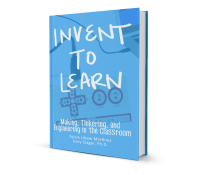When we talk about making, there is a tendency to overlap our terms, like saying we’re going to “do makerspace”. I think unpacking these terms help uncover underlying assumptions, especially when designing new spaces and learning opportunities. I see this as four distinct aspects that work together:
- Place – Makerspace, hackerspace, Fab Lab, Techshop, shop, science lab, open classroom, studio
- Culture – Maker movement, hacker culture, craft, green, economic self-determinism, service-learning, artisanal, amateur science, citizen science, urban agriculture, slow food
- Process – Making, tinkering, Design Thinking, design, Genius Hour, PBL
- Underlying belief about teaching & learning – Instructionism, behaviorism, constructivism, constructionism
By looking at these four aspects, we can untangle some of the confusion about what “making” in education is. These can combine in interesting ways – you can have a Design Thinking program that is strongly teacher directed in a makerspace that has a green eco-streak that permeates the projects. The place doesn’t dictate the process, which is good and bad.
Many times, when designing new learning opportunities or spaces it is assumed that their current culture will transform as well. Space planning doesn’t magically transform pedagogy. You can’t assume that just because you build a flexible space with terrific materials, it will magically be filled with wonderful student-centered, open-ended projects.
Here’s a “cheat sheet” for the four aspects.
Place
Both formal (credit-bearing courses, primarily at schools) and informal (extra-curricular activities, clubs, libraries, museums, community organizations, commercial spaces)
- Hackerspace – “Hacking” indicates both an activity and political belief that systems should be open to all people to change and redistribute for the greater good. (roots in the 1960’s). More prevalent in Europe than US.
- Makerspace – MAKE magazine (2005 – present). Popular Science for the 21st century. DIY and DIWO. Maker Faires. Adopted as a softer, safer alternative to hackerspace. Can be a separate room or integrated into classrooms.
- Fab Lab – Spaces connected to the MIT Center for Bits and Atoms (565 worldwide) with a common charter and specific requirements for space and tools. Fablab also used as a generic nickname for any fabrication lab.
- TechShop (and others) – non-profit or commercial organizations offering community tool sharing, classes, or incubation space.
- Shop, science lab, classroom, studio – traditional names for school spaces for learning via hands-on activities.
Culture
- Maker movement – technology-based extension of DIY culture, incorporating hobbyist tools to shortcut a traditional (corporate) design and development process, and the internet to openly share problems and solutions. Maker mindset – a positive, energized attitude of active tinkering to solve problems, using any and all materials at hand.
- Hacker/hacking – Essential lessons about the world are learned “..from taking things apart, seeing how they work, and using this knowledge to create new and even more interesting things.” – Steven Levy
- Green – values of ecology, conservation, and respect for the environment.
- Citizen/amateur science – participation of non-professional scientists in gathering and interpreting data or collaborating in research projects.
- Artisanal/craft movements – engaging in mindful and ethical practices to humanize activities, products, and production.
Process
- Making – the act of creation. “Learning by making happens only when the making changes the maker.” – Sylvia Martinez
- Tinkering – non-linear, iterative approach to reaching a goal. “messing about” with materials, tools, and ideas. “Making, fixing, and improving mental constructions.” – Seymour Papert
- Design Thinking – customer-centered product design and development process popularized by IDEO and the Stanford d.school
- Design – “to give form, or expression, to inner feelings and ideas, thus projecting them outwards, making them tangible.” – Edith Ackermann
- Genius Hour – specific classroom time devoted to tinkering and open-ended projects. Patterned after companies (Google and FedEx, primarily) that allow employees to work on non-company projects on company time, thereby boosting morale and possibly resulting in products useful to the company.
- Project-based Learning (PBL) – Projects are…“work that is substantial, shareable, and personally meaningful.” – Martinez & Stager
Beliefs about teaching and learning
- Instructionism – Belief that learning is the result of teaching. Lecture, direct instruction.
- Behaviorism – Belief that behavior is a result of reinforcement and punishment. Rote learning, worksheets, stars/stickers, grades.
- Constructivism – Piagetian idea that learning is a personal, internal reconstruction—not a transmission of knowledge. Socratic method, modeling, manipulatives, experiments, research, groupwork, inquiry.
- Constructionism – Seymour Papert extended constructivism with the idea that learning is even more effective when the learner is creating a meaningful, shareable artifact. PBL, making, citizen science.




 In “
In “